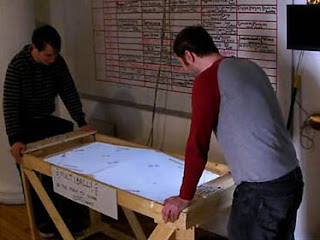 Like many people, my initial experience with Minecraft involved first thinking, 'this game looks terrible!' and then coming up for air 48 hours later, charmed and hooked.
Like many people, my initial experience with Minecraft involved first thinking, 'this game looks terrible!' and then coming up for air 48 hours later, charmed and hooked.Many of my thoughts while playing have been about the relationship between the visual look and shape of the game, and its underlying structure. The blockiness, I think, is one of the keys to the game's satisfaction -- the system is simple enough to make any individual action predictable and satisfying, while being complicated enough to allow for grand schemes and emergent complexity.
For the most part, when I play, I mentally edit out the textures in the game to their symbolic meanings -- I don't care so much what dirt looks like, so long as I know it is dirt and understand its behaviors and relationships to other blocks and items.
But when I saw that people were playing with texture packs, I looked again at how I play. Would giving the game a different look make for a meaningfully different experience?
Most of the texture packs I downloaded attempt to make the textures look better without making them much different. A block of dirt that looks more dirt-like or matches a specific esthetic theme. Patches to support higher resolution blocks that look even more dirt-like.
At first I started (and am still in the process of) making a texture pack that is simply more visually appealing to my eye. But I still wonder how far the relationship between the look and the structure can be stretched. Is the game playable when stripped down to its symbolic meaning? Would it be feasible to add a drastically different system of narrative interpretation onto the same set of blocks and attendant behaviors and relationships?
 As a first step, and to while away some of those London-is-shut-for-the-holidays hours, I made a text-based texture pack. Almost everything has been changed from an image into text on a white or transparent background.
As a first step, and to while away some of those London-is-shut-for-the-holidays hours, I made a text-based texture pack. Almost everything has been changed from an image into text on a white or transparent background.It's still a bit rough around the edges, but it gets the idea across. As a side benefit, the image files themselves serve as a sort of cheat sheet for block IDs.
The shapes remain. The relationships remain. And it's (mostly) playable.

To install:
*Download TEXT.zip.
*Follow these instructions on the minecraft wiki.




















